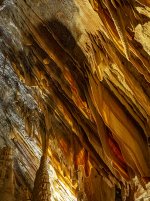Tim Pickering
Member
I recall years back reading an article on how frequent flash photography had been linked to the blackening of straws in a show cave in France. I'm aware that blackening of speleothems was once a result of sooty deposits from early forms of show cave lighting. However, this is more recent. I was having a conversation with a colleague today and offered to send her the information I had on the topic but for the life of me, I can find no trace of such info on my 'puter! I'm starting to worry it may have been one of my far-too-realistic dreams. I could have sworn I read that a paper had been written on the subject, yet Google Scholar is reluctant to assist me.
Has anyone come across this paper?
My (very) limited grasp of physics led me to suppose that perhaps the intensity of light produced from a flash might be enough to excite the molecules in the calcite perhaps resulting in calcium hydroxide, carbon and whatever other species? Please excuse my rudimentary understanding of chemistry (one might call it basic 😂), hence this post.
Has anyone come across this paper?
My (very) limited grasp of physics led me to suppose that perhaps the intensity of light produced from a flash might be enough to excite the molecules in the calcite perhaps resulting in calcium hydroxide, carbon and whatever other species? Please excuse my rudimentary understanding of chemistry (one might call it basic 😂), hence this post.








